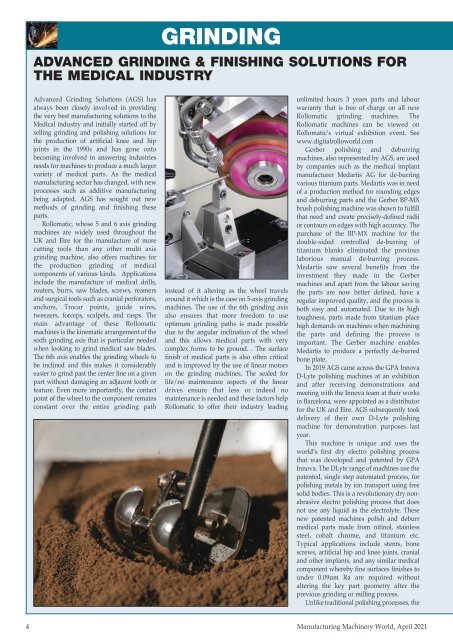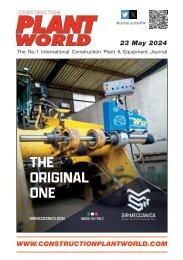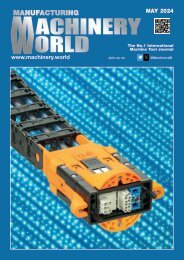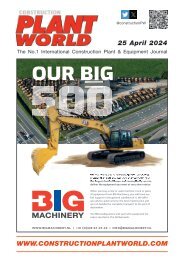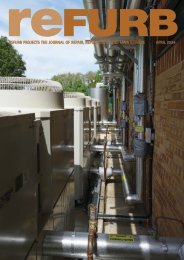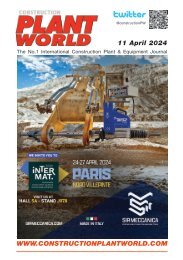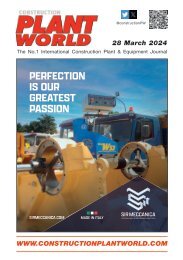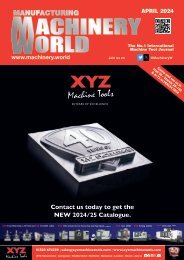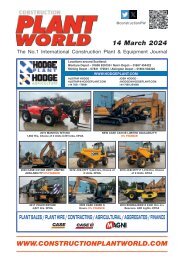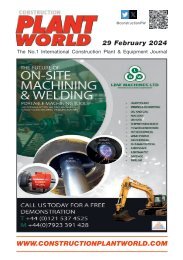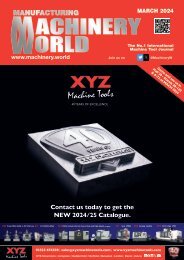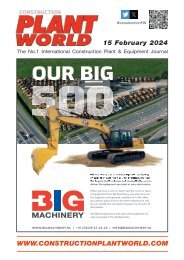Manufacturing Machinery World April 2021
Machinery World was launched in 1982 to serve the machinery & production engineering market. Editorially Machinery World is a news and information source that gives direct contact with the provider of innovative services and equipment. Editorial is available both online and as hard copy.
Machinery World was launched in 1982 to serve the machinery & production engineering market.
Editorially Machinery World is a news and information source that gives direct contact with the provider of innovative services and equipment. Editorial is available both online and as hard copy.
You also want an ePaper? Increase the reach of your titles
YUMPU automatically turns print PDFs into web optimized ePapers that Google loves.
GRINDING<br />
ADVANCED GRINDING & FINISHING SOLUTIONS FOR<br />
THE MEDICAL INDUSTRY<br />
Advanced Grinding Solutions (AGS) has<br />
always been closely involved in providing<br />
the very best manufacturing solutions to the<br />
Medical industry and initially started off by<br />
selling grinding and polishing solutions for<br />
the production of artificial knee and hip<br />
joints in the 1990s and has gone onto<br />
becoming involved in answering industries<br />
needs for machines to produce a much larger<br />
variety of medical parts. As the medical<br />
manufacturing sector has changed, with new<br />
processes such as additive manufacturing<br />
being adapted, AGS has sought out new<br />
methods of grinding and finishing these<br />
parts.<br />
Rollomatic, whose 5 and 6 axis grinding<br />
machines are widely used throughout the<br />
UK and Eire for the manufacture of more<br />
cutting tools than any other multi axis<br />
grinding machine, also offers machines for<br />
the production grinding of medical<br />
components of various kinds. Applications<br />
include the manufacture of medical drills,<br />
routers, burrs, saw blades, screws, reamers<br />
and surgical tools such as cranial perforators,<br />
anchors, Trocar points, guide wires,<br />
tweezers, forceps, scalpels, and rasps. The<br />
main advantage of these Rollomatic<br />
machines is the kinematic arrangement of the<br />
sixth grinding axis that is particular needed<br />
when looking to grind medical saw blades.<br />
The 6th axis enables the grinding wheels to<br />
be inclined and this makes it considerably<br />
easier to grind past the center line on a given<br />
part without damaging an adjacent tooth or<br />
feature. Even more importantly, the contact<br />
point of the wheel to the component remains<br />
constant over the entire grinding path<br />
instead of it altering as the wheel travels<br />
around it which is the case on 5-axis grinding<br />
machines. The use of the 6th grinding axis<br />
also ensures that more freedom to use<br />
optimum grinding paths is made possible<br />
due to the angular inclination of the wheel<br />
and this allows medical parts with very<br />
complex forms to be ground. . The surface<br />
finish of medical parts is also often critical<br />
and is improved by the use of linear motors<br />
on the grinding machines. The sealed for<br />
life/no maintenance aspects of the linear<br />
drives ensure that less or indeed no<br />
maintenance is needed and these factors help<br />
Rollomatic to offer their industry leading<br />
unlimited hours 3 years parts and labour<br />
warranty that is free of charge on all new<br />
Rollomatic grinding machines. The<br />
Rollomatic machines can be viewed on<br />
Rollomatic’s virtual exhibition event. See<br />
www.digitalrolloworld.com<br />
Gerber polishing and deburring<br />
machines, also represented by AGS, are used<br />
by companies such as the medical implant<br />
manufacturer Medartis AG for de-burring<br />
various titanium parts. Medartis was in need<br />
of a production method for rounding edges<br />
and deburring parts and the Gerber BP-MX<br />
brush polishing machine was shown to fulfill<br />
that need and create precisely-defined radii<br />
or contours on edges with high accuracy. The<br />
purchase of the BP-MX machine for the<br />
double-sided controlled de-burring of<br />
titanium blanks eliminated the previous<br />
laborious manual de-burring process.<br />
Medartis saw several benefits from the<br />
investment they made in the Gerber<br />
machines and apart from the labour saving<br />
the parts are now better defined, have a<br />
regular improved quality, and the process is<br />
both easy and automated. Due to its high<br />
toughness, parts made from titanium place<br />
high demands on machines when machining<br />
the parts and defining the process is<br />
important. The Gerber machine enables<br />
Medartis to produce a perfectly de-burred<br />
bone plate.<br />
In 2019 AGS came across the GPA Innova<br />
D-Lyte polishing machines at an exhibition<br />
and after receiving demonstrations and<br />
meeting with the Innova team at their works<br />
in Barcelona, were appointed as a distributor<br />
for the UK and Eire. AGS subsequently took<br />
delivery of their own D-Lyte polishing<br />
machine for demonstration purposes last<br />
year.<br />
This machine is unique and uses the<br />
world’s first dry electro polishing process<br />
that was developed and patented by GPA<br />
Innova. The DLyte range of machines use the<br />
patented, single step automated process, for<br />
polishing metals by ion transport using free<br />
solid bodies. This is a revolutionary dry nonabrasive<br />
electro polishing process that does<br />
not use any liquid as the electrolyte. These<br />
new patented machines polish and deburr<br />
medical parts made from nitinol, stainless<br />
steel, cobalt chrome, and titanium etc.<br />
Typical applications include stents, bone<br />
screws, artificial hip and knee joints, cranial<br />
and other implants, and any similar medical<br />
component whereby fine surfaces finishes to<br />
under 0.09um Ra are required without<br />
altering the key part geometry after the<br />
previous grinding or milling process.<br />
Unlike traditional polishing processes, the<br />
4 <strong>Manufacturing</strong> <strong>Machinery</strong> <strong>World</strong>, <strong>April</strong> <strong>2021</strong>


